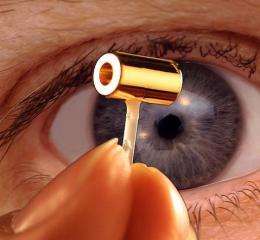March 15, 2011 report
Physicists demonstrate conditions for laser-driven fusion

(PhysOrg.com) -- Currently, commercial nuclear power plants generate electricity using nuclear fission, in which an atom’s nucleus is split into lighter nuclei. But scientists are also researching the reverse reaction, nuclear fusion, in which two light atomic nuclei fuse to form a single heavier nucleus. Compared with fission, fusion has the potential to produce less radioactive waste while still generating large amounts of energy.
So far, scientists have not yet been able to produce nuclear fusion on a large commercial scale. But two new studies published in Physical Review Letters by scientists at the National Ignition Facility (NIF), which officially opened last year at the Lawrence Livermore National Laboratory in Livermore, California, have produced some promising results.
The scientists are developing inertial confinement fusion (ICF), a type of fusion in which high-energy lasers heat and compress an inch-long gold fuel pellet called a “hohlraum” that contains the hydrogen isotope nuclei to be fused. The goal of ICF reactions is to achieve ignition, where the fusion reactions generate enough heat to be self-sustaining. The scientists hope that the fusion reactions inside the fuel pellets will generate 10-20 times more energy than that provided by the lasers that start the reactions.
In their recent experiments, the scientists at the NIF have achieved two of the most important components of ignition: extremely high “Sun-like” temperatures and uniform compression so that the targets don’t lose their shape. In the current experiments, the scientists used two-millimeter-diameter plastic spheres as the targets instead of hohlraums because they were easier to analyze.
The experiment involved focusing 192 laser beams onto the plastic spheres, each of which contained helium. The lasers generated large amounts of heat energy that was converted to X-rays with nearly 90% efficiency, and produced temperatures of up to 3.6 million degrees Celsius (300 eV). At these temperatures, the diameters of the two-millimeter spheres shrunk to about one-tenth of a millimeter.
While these conditions look promising, true ignition will involve some different components. Instead of helium, the fuel pellets will contain the element beryllium, which itself will contain the hydrogen isotopes deuterium and tritium. The laser-generated X-rays will cause the beryllium to explode, producing a reactive inward implosion that sends shockwaves into the hydrogen isotopes. The shockwaves further increase the temperature of the deuterium and tritium nuclei to the point where they can overcome their mutual repulsion and fuse.
The current experiments have simulated the conditions for such a reaction to occur in a more realistic way that any previous experiment. However, the researchers plan to take small steps toward the final goal of ignition. They’re currently testing spheres that contain unequal quantities of deuterium and tritium in order to investigate the possibility of asymmetric implosions.
Edward Moses, Associate Director of the NIF, hopes that the facility will demonstrate actual ignition in the spring or summer of 2012. However, he cautions that technical and scientific setbacks could interfere with the timeline. For instance, last January, Moses and others at the NIF had hoped to demonstrate ignition by the end of 2010.
More information: J. L. Kline, et al. "Observation of High Soft X-Ray Drive in Large-Scale Hohlraums at the National Ignition Facility." Physical Review Letters 106, 085003.
S. H. Glenzer, et al. "Demonstration of Ignition Radiation Temperatures in Indirect-Drive Inertial Confinement Fusion Hohlraums." Physical Review Letters 106, 085004.
via: Physics World
© 2010 PhysOrg.com



















